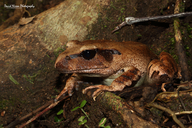|
Description
Diagnosis: Can be distinguished from other members of the Mixophyes schevilli species complex by the following combination of characters: 1-13 symmetrical pale blotches with dark borders, 1-6 mm in diameter, concentrated on the distal thigh for M. schevilli, vs. 0-9 large irregular pale blotches with dark borders, 1-11 mm in diameter, concentrated on the distal thigh for M. coggeri, or posterior surface of thighs uniformly dark with many small pale rounded spots (9-35 spots per thigh, 1.0-1.7 mm in diameter), evenly distributed along the length of the thigh for M. carbinensis. In M. carbinensis the patterning on the dorsal and posterior surfaces of the leg is more visible as it contrasts more strongly with the ground color than in M. schevilli and M. coggeri. M. schevilli can also be distinguished from M. coggeri by having a continuous mid-dorsal stripe, vs. a discontinuous linear series of large irregular blotches in M. coggeri, and by having a smaller head (Mahony et al. 2006).
The M. schevilli species complex can be distinguished from all other Mixophyes species except for M. iteratus, by the combination of the following two characters: (1) the length of the inner metatarsal tubercles is half the length of the first toe (shorter than in other species); (2) toe webbing extends to the second most distal joint of the fourth toe (less webbed than in other species). Taxa in this complex can be distinguished from M. iteratus by the pattern of dark spots on the side: few to none in M. schevilli complex species vs. numerous in M. iteratus (Mahony et al. 2006).
Description: Males 58-75 mm SVL, females 68-92 mm SVL. Flattened head. Prominent rounded snout with well-defined, slightly concave canthus rostralis, and nearly flat, laterally inclined loreal region. Nares equidistant between snout and eye. Eyes are large, with pupils that are vertical when constricted. Tympanum large and oval, with the vertical axis the longest one. Vomerine dentigerous processes are relatively long and oblique rows, angled from the anterior of the choanae to the midline between the choanae. Tongue rectangular, lacking posterior notch. Fingers are long and slender and lack webbing. Relative length of fingers: III>I>IV>II. Hind limbs long (TL/SVL = 0.61). Subarticular and palmar tubercles are well-developed. Toes have extensive webbing, reaching discs on Toes I-III and V, and to the second most distal joint of Toe IV. Relative length of toes IV>V>III>II>I. Subarticular tubercles ovoid. Inner metatarsal tubercles is prominent with distinct outer edge; outer metatarsal tubercles is absent. Dorsum tuberculate, with small tubercles; venter is smooth (Mahony et al. 2006).
Dorsal surfaces can be pale yellow to copper brown to dark brown. Darker mid-dorsal stripe, mid-dorsal patches, face patch, and bars on limbs. Black head stripe may extend as far as axilla, and is bordered by fine light line that stands out against the black stripe but shades into the ground color. Posterior dorsal surface may have sparse black spots or a few larger blotches. Tympanum is same color as dorsum, or may be darker brown. Upper lip with small dark brown to black blotches. Suborbital dark blotches. Iris dark brown. Venter and chin cream, with gray hue towards jaw. Towards groin area, irregular dark blotches may be present. Ventral surfaces of limbs is off-white. Posterior thigh brown to dark gray, with large irregular light blotches having a darker border. Triangular dark brown to black patches on limb sides. Dorsal surfaces of fingers and toes are the same shade as the ground color. Webbing is black. Nuptial pad of males is gray to brown (Mahony et al. 2006). Distribution and Habitat
Country distribution from AmphibiaWeb's database: Australia
Endemic to northeastern Queensland, Australia. Disjunct distribution: Big Tableland, Thornton Peak, and the Atherton Tableland (from north to south, Lamb Range to Charmillan Creek)(Mahony et al. 2006), from 100-1,500 m asl (Alford et al. 2008).
Life History, Abundance, Activity, and Special Behaviors
Around fast-flowing streams and nearby pools in mountainous rainforest.
Spring and summer breeder. Males call from leaf litter or buried up to 5cm under leaf litter near streams and ponds. Eggs are laid on the ground and around the roots of plants at water level besides streams and pools (Alford et al. 2008).
Trends and Threats
Although it is not often seen, it is common where found; there have been no known declines and much of the habitat is protected (Alford et al. 2008).
Threats
In the past, habitat loss from logging and clearing for farmland was a threat. Now this species is more likely to be threatened by habitat degradation through tourism and recreation (graded trails and small recreation areas). However, M. schevilli can persist in these areas if suitable rainforest habitat is available (Alford et al. 2008).
Conservation Measures
Much of habitat is protected within National Parks and State Forests, especially in north Queensland part of its range (Alford et al. 2008).
References
Alford, R., Cunningham, M., McDonald, K., Retallick, R., and Richards, S. (2008). Mixophyes schevilli. In: IUCN 2010. IUCN Red List of Threatened Species. Version 2010.1. www.iucnredlist.org. Downloaded on 22 May 2010.
Barker, J., Grigg, G. C., and Tyler, M. J. (1995). A Field Guide to Australian Frogs. Surrey Beatty and Sons, New South Wales.
Mahony, M., Donnellan, S. C., Richards, S. J., and McDonald, K. (2006). ''Species boundaries among barred river frogs, Mixophyes (Anura: Myobatrachidae) in north-eastern Australia, with descriptions of two new species.'' Zootaxa, 1228, 35-60.
McDonald, K.R. (1992). ''Distribution patterns and conservation status of north Queensland rainforest frogs.'' Conservation Technical Report No. 1. Queensland Department of Environment and Heritage, Queensland.
Originally submitted by: Jean-Marc Hero et. al. (first posted 2002-04-05)
Edited by: Ambika Sopory, Jean-Marc Hero, Kellie Whittaker (2010-05-21)Species Account Citation: AmphibiaWeb 2010 Mixophyes schevilli: Northern Barred Frog <https://amphibiaweb.org/species/3523> University of California, Berkeley, CA, USA. Accessed Nov 23, 2024.
Feedback or comments about this page.
Citation: AmphibiaWeb. 2024. <https://amphibiaweb.org> University of California, Berkeley, CA, USA. Accessed 23 Nov 2024.
AmphibiaWeb's policy on data use.
|
